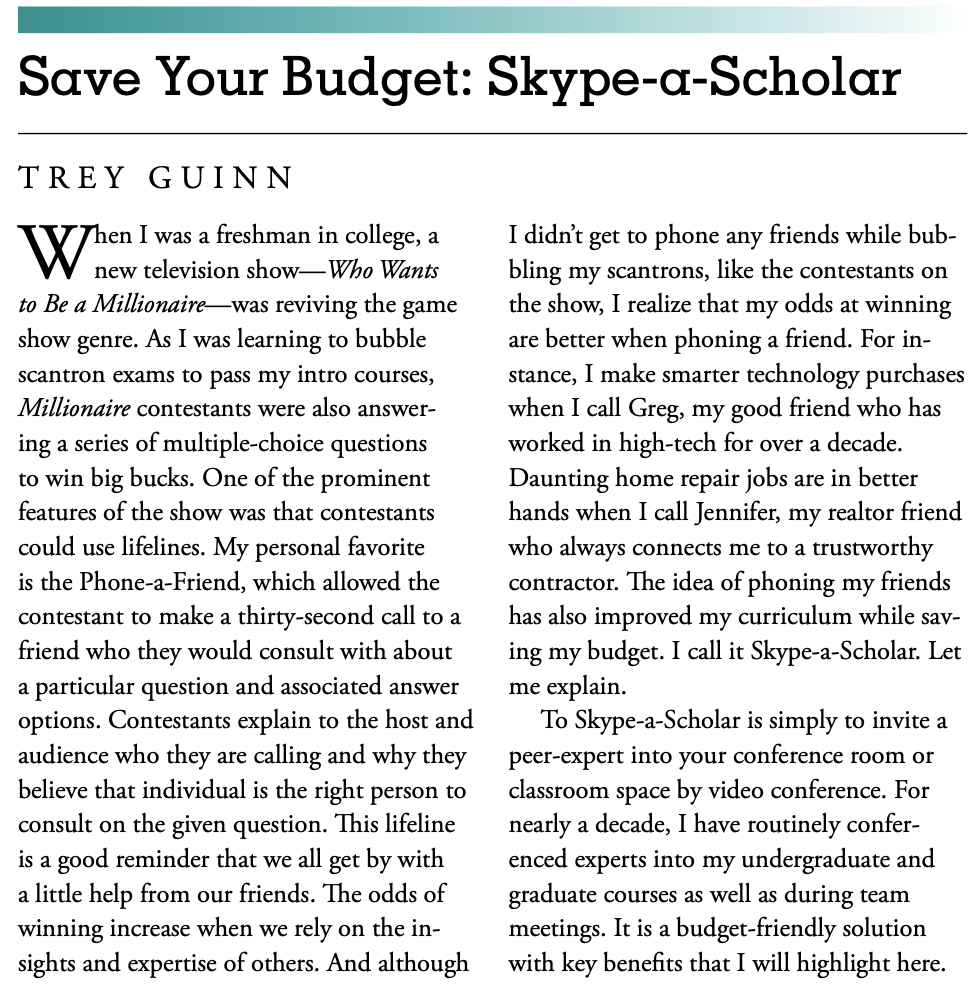SAMPLING OF RECENT ARTICLES
SAVE YOUR BUDGET: SKYPE A SCHOLAR
When I was a freshman in college, a new television show—Who Wants to Be a Millionaire—was reviving the game show genre. As I was learning to bubble scantron exams to pass my intro courses, Millionaire contestants were also answering a series of multiple-choice questions to win big bucks. One of the prominent features of the show was that contestants could use lifelines. My personal favorite is the Phone-a-Friend, which allowed the contestant to make a thirty-second call to a friend who they would consult with about a particular question and associated answer options. Contestants explain to the host and audience who they are calling and why they believe that individual is the right person to consult on the given question. This lifeline is a good reminder that we all get by with a little help from our friends. The odds of winning increase when we rely on the insights and expertise of others. And although I didn’t get to phone any friends while bubbling my scantrons, like the contestants on the show, I realize that my odds at winning are better when phoning a friend.
EXECUTIVE PRESENCE FOR THE ACADEMIC CHAIR
In the last decade, I have led countless coaching appointments and delivered numerous keynote addresses and workshops around the topic of executive presence. A Google search of executive presence and related terms yields nearly a billion results. When you cut through the fluff, you quickly identify that much of exercising executive presence can be broken down into simple, actionable items. I will focus on just three for this article: being a compelling communicator, controlling your anxiety, and exuding confidence.
TWO ACTION ITEMS FOR BUILDING CONSENSUS AND IMPROVING WORKPLACE RELATIONSHIPS
You arrive to the meeting prepared. In addition to the standard talking points and discussion items, you are ready to brief your faculty colleagues on a small problem facing your department, which you foresee will be of little concern because you also have prepared a suitable solution. To your dismay, however, there is little consensus about your proposed solution, and before long, your idea for how to address the problem has derailed the meeting, divided the room, and bruised a few egos.
MAXIMIZE THE MOMENT: CHAIRS AND THE LEARNING COMMUNITY IN CRISIS
COVID-19 is top of mind, front and center, and continues to drive most conversations in the media, (virtual) workspace, and among family, friends, and communities across the globe. In addition to the actual health crisis and associated compromises to well-being, the upheaval to business as usual continues to be tremendous. Colleges and universities everywhere are not immune but instead play a central role in all this. Students being displaced and learning environments being in transition are part of the evidence suggesting that higher education is feeling a bit upside down.
While many of our colleagues are eager to return to normal, I pray that we don’t. Let us not waste this crisis. A rubber band stretched is designed to return to its original form, but we can be different and do better.
Click below to participate in an ongoing project.




